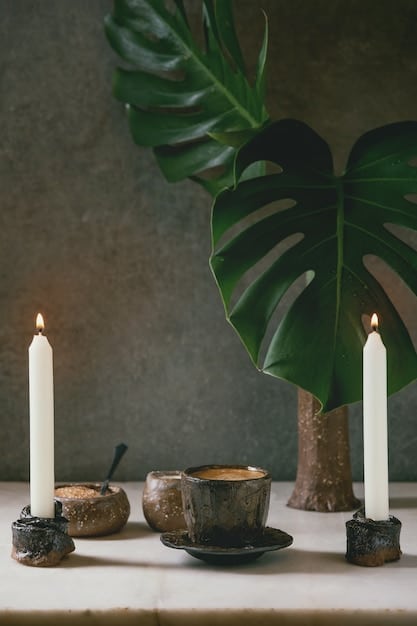Create a Sacred Space: Your Guide to Daily Spiritual Practice at Home

Creating a sacred space in your home involves designating a specific area and infusing it with elements that promote peace, reflection, and spiritual connection, allowing for daily practices that nourish your mind, body, and soul.
Creating a personal sanctuary within your home can significantly enhance your daily spiritual practice. It’s about crafting a space that resonates with your soul, providing a refuge from the stresses of everyday life. Let’s explore how to create a sacred space that fosters peace, reflection, and deeper spiritual connection.
Understanding the Essence of a Sacred Space
Before diving into the how-to, let’s clarify what a sacred space truly is. It’s more than just a visually appealing area; it’s a dedicated environment that supports your inner journey. It’s a place where you can disconnect from the external world and connect with your inner self.
What Makes a Space Sacred?
A sacred space is defined by its intention and the energy you invest in it. It’s a place intentionally set aside for practices that nurture your spiritual, emotional, and mental well-being.
The Benefits of Having a Sacred Space
Having a designated sacred space can dramatically improve your spiritual practice by providing a consistent and familiar environment for reflection and meditation.
- Enhances focus and reduces distractions.
- Provides a sense of peace and calm.
- Facilitates deeper spiritual connection.
- Encourages consistent daily practice.
Ultimately, the essence of a sacred space lies in its ability to act as a catalyst for inner peace and spiritual growth. It’s a personalized sanctuary that reflects your unique spiritual path and intentions.
Choosing the Right Location in Your Home
Selecting the perfect spot is the first step in creating your sacred space. The location can significantly influence the energy and effectiveness of your practice. Consider areas that offer tranquility and privacy.

Factors to Consider When Choosing a Location
Several factors can help you determine the ideal location for your sacred space, ensuring it supports your spiritual practice effectively.
Consider the practical and energetic aspects of the location. Choose a place that feels right and aligns with your spiritual needs.
Transforming Small Spaces into Sacred Retreats
Even if you live in a small apartment, you can still create a powerful sacred space. It’s about making the most of what you have.
- Use corners or alcoves to define the space.
- Utilize screens or curtains for privacy.
- Keep the area clutter-free and organized.
- Incorporate vertical elements, like tall plants or shelves, to draw the eye upward.
Choosing the right location is a vital step in creating a sacred space that resonates with your soul. By carefully considering the energy, privacy, and practicality of the location, you can create a powerful sanctuary for daily spiritual practice.
Infusing Your Space with Personal Meaning
The beauty of creating a sacred space is the opportunity to infuse it with personal meaning. Incorporating objects and symbols that resonate with you can deepen your connection to the space and enhance your spiritual practice.

Selecting Objects and Symbols That Resonate with You
Choose items that hold significance for you, whether they are religious symbols, nature elements, or personal mementos. These objects serve as reminders of your intentions and values.
The Power of Colors and Textures
Colors and textures can significantly impact the atmosphere of your sacred space. Choose elements that evoke feelings of peace, joy, or inspiration.
- Use calming colors like blues, greens, and purples.
- Incorporate natural textures like wood, stone, and cotton.
- Add soft fabrics for comfort and warmth.
- Ensure good lighting to create the right ambiance.
Infusing your sacred space with personal meaning is about creating an environment that speaks directly to your soul. By carefully selecting objects, symbols, colors, and textures, you can transform a simple space into a profound sanctuary that supports your spiritual journey.
Incorporating Elements of Nature
Bringing elements of nature into your sacred space can create a grounding and revitalizing atmosphere. Nature has a way of connecting us to something larger than ourselves, making it a powerful addition to any spiritual practice.
Plants and Their Energetic Properties
Plants not only beautify your space but also bring life and positive energy. Different plants have different properties, so choose ones that resonate with your intentions.
The Role of Natural Light and Air
Natural light and fresh air are essential for creating a vibrant and healthy sacred space. They can uplift your mood and enhance your connection to the present moment.
- Open windows regularly to circulate fresh air.
- Position your space near a window to maximize natural light.
- Use sheer curtains to diffuse light and create a soft glow.
- Consider using a salt lamp to purify the air.
Incorporating elements of nature into your sacred space brings a sense of harmony and balance. By including plants, natural light, fresh air, and symbolic representations of nature, you can create a sanctuary that rejuvenates your spirit and deepens your connection to the earth.
Setting Intentions and Establishing Rituals
The true power of a sacred space lies in the intentions you set and the rituals you establish within it. These practices transform the space from merely a physical location into a dynamic center for spiritual growth.
Creating a Daily Spiritual Practice
Consistency is key in developing a meaningful spiritual practice. Set aside a specific time each day to engage in activities that nourish your spirit.
Rituals to Start and End Your Practice
Establishing rituals to begin and end your practice can help create a sense of closure and deepen your connection to the sacred space.
- Light a candle or burn incense to signify the start of your practice.
- Take a few deep breaths to center yourself.
- Recite an affirmation or prayer to set your intention.
- Express gratitude at the end of your practice.
By setting intentions and establishing rituals, you imbue your sacred space with purpose and meaning. These practices reinforce your commitment to spiritual growth and transform your space into a powerful sanctuary for daily renewal and reflection.
Maintaining the Energy of Your Sacred Space
Once you’ve created your sacred space, it’s essential to maintain its energy to ensure it remains a supportive environment for your spiritual practice. Regular care and attention will keep the space vibrant and effective.
Regular Cleansing and Clearing
Cleansing your sacred space regularly helps to remove any stagnant or negative energy that may accumulate over time. This can be done through various methods, such as smudging or using sound.
Keeping the Space Tidy and Organized
A clutter-free space promotes mental clarity and focus. Regularly declutter and organize your sacred space to maintain a sense of order and tranquility.
- Remove any items that no longer serve your purpose.
- Organize objects in a way that feels harmonious and balanced.
- Dust and clean the space regularly.
- Keep the area visually appealing and inviting.
Maintaining the energy of your sacred space is an ongoing process that requires commitment and mindfulness. By regularly cleansing, organizing, and updating your space, you can ensure it remains a potent sanctuary for spiritual growth and renewal.
| Key Aspect | Brief Description |
|---|---|
| 📍 Location | Choose a quiet, private area in your home. |
| 🌿 Elements | Incorporate plants, natural light, and meaningful objects. |
| 🙏 Rituals | Establish daily practices to deepen your spiritual connection. |
| 🧹 Maintenance | Regularly cleanse and organize the space to maintain positive energy. |
Frequently Asked Questions
▼
A sacred space is a dedicated area designed to foster spiritual connection and inner peace, providing a refuge for reflection and practice.
▼
Choose a quiet location with minimal distractions, where you feel comfortable and at peace. A corner of a room can work well.
▼
Include items that resonate with you, such as candles, crystals, plants, religious symbols, or personal mementos that inspire and uplift you.
▼
Cleanse your space regularly, ideally once a week or whenever you feel the energy is stagnant. Use methods like smudging, sound, or visualization.
▼
Start with a few deep breaths, light a candle, set an intention, meditate, journal, or practice gratitude daily to deepen your spiritual connection.
Conclusion
Creating a sacred space in your home is a deeply personal and transformative journey. By following these guidelines and infusing your space with intention and care, you can create a sanctuary that supports your spiritual growth and brings peace and harmony into your daily life.





